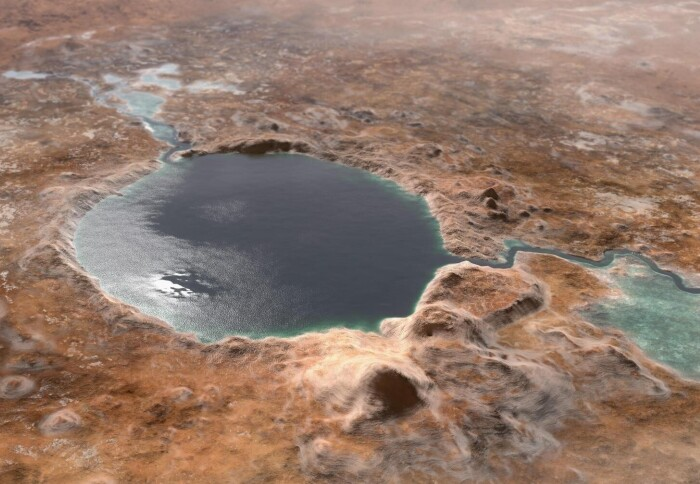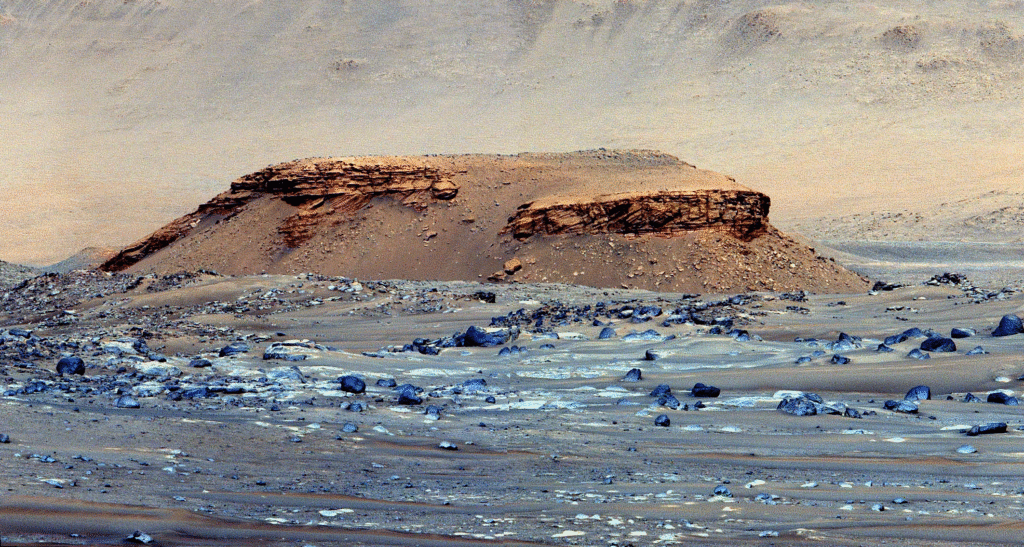Jezero Crater | Possible Signs of Ancient Life | NASA’s Mars rover, has collected a rock sample from Jezero Crater that contains a potential biosignature, researchers reported in a paper published in Nature. The sample taken last year from a rock called Cheyava Falls and labeled “Sapphire Canyon” shows mineral and chemical features that could reflect past microbial activity, though scientists emphasize more study is needed before any conclusion about life can be reached.
Discovery at the Bright Angel formation
In July 2024, while traversing the Bright Angel formation an array of sedimentary outcrops on the edges of Neretva Vallis Perseverance investigators examined an arrowhead-shaped rock about 1 meter by 0.6 meter known as Cheyava Falls.

Instruments on the rover, notably PIXL (Planetary Instrument for X-ray Lithochemistry) and SHERLOC (Scanning Habitable Environments with Raman & Luminescence for Organics & Chemicals), documented colorful spots and a distinct mineral pattern the team nicknamed “leopard spots.”
Minerals, organics and reaction fronts
High-resolution analyses revealed that the spotted areas carry signatures of two iron-rich minerals vivianite (a hydrated iron phosphate) and greigite (an iron sulfide). The surrounding rocks were found to be sedimentary rich in clay and silt and also contain organic carbon, sulfur, oxidized iron (rust), and phosphorus.

On Earth, clay-rich sediments are excellent at preserving traces of past microbial life, and the particular mineral combination observed could form via electron-transfer reactions between sediments and organic matter processes that some microbes use to obtain energy.
Why scientists are cautious
NASA investigators are careful not to overstate the finding. A potential biosignature is, by definition, a substance or structure that might have a biological origin but requires additional evidence to confirm. The minerals identified can also form through abiotic (non-biological) pathways such as sustained high temperatures, acidic conditions, or interactions with organic molecules so alternative explanations remain plausible.
Importantly, the rocks at Bright Angel do not show evidence for the high temperatures or acidic conditions that produce some abiotic pathways, and it is not yet known whether the organic compounds present could catalyze the observed reactions under low-temperature conditions.
Voices from the mission
Acting NASA Administrator Sean Duffy called the result “the closest we have ever come to discovering life on Mars,” and framed it as a significant scientific milestone. Nicky Fox, associate administrator for NASA’s Science Mission Directorate, stressed that peer-reviewed publication is critical because it makes the data available to the broader scientific community for independent analysis.
Also Read: NASA Wants a Nuclear Reactor on the Moon—Here’s the Real Reason Why
Joel Hurowitz, lead author of the paper, noted that while the chemical signatures are compelling and could have supported microbial metabolisms the data still need careful interpretation. Katie Stack Morgan, Perseverance’s project scientist, reiterated that extraordinary claims require extraordinary evidence and that abiotic explanations cannot yet be ruled out.
Timeline and habitability implications
One surprising element of the discovery is that the rocks showing these features are relatively young sedimentary deposits compared with older formations previously targeted for signs of ancient life. That observation raises the possibility that habitable conditions on Mars could have persisted later in the planet’s history than earlier hypotheses suggested, though confirming that will require more data and analysis.
Scientific frameworks and next steps
Researchers will evaluate the finding using established assessment tools such as the CoLD scale and the Standards of Evidence for life-detection claims. By publishing the peer-reviewed results, NASA has made the measurements available so the wider scientific community can test, reproduce, and challenge interpretations, an essential step in determining whether the signatures recorded at Bright Angel are biological in origin.
A defining moment for Mars research
This potential biosignature from Jezero Crater represents a careful, peer-reviewed result that advances the search for past life on Mars without claiming finality. The combination of clay-rich sediments, organic carbon, and distinctive mineral patterns provides a plausible context for preserved biosignatures, yet scientists emphasize that abiotic processes remain possible explanations.

By releasing the data to the scientific community, NASA opens the door for broader scrutiny and follow-up studies that will be necessary to confirm or refute the biological interpretation. Whatever the outcome, the finding sharpens research priorities and deepens scientific inquiry into Mars’ ancient environments.
Spiritual Insight: Science Meets the Divine Knowledge of Saint Rampal Ji Maharaj
While NASA’s discovery of a potential biosignature on Mars excites the scientific world, it also raises deeper spiritual questions: What is the true origin of life, and where does humanity stand in the vast creation? According to the spiritual wisdom of Tatvdarshi Saint Rampal Ji Maharaj, the mysteries of life and the universe cannot be fully understood through science alone.
His teachings explain that while scientific research uncovers parts of creation, the complete truth about life’s purpose and existence lies in realizing the Supreme Power.
For authentic spiritual knowledge that connects science with the eternal truth, visit www.jagatgururampalji.org
FAQs on NASA’s Perseverance Rover Potential Biosignature Discovery
1. What did NASA’s Perseverance rover discover in Jezero Crater?
The rover collected a rock sample named Sapphire Canyon from Cheyava Falls that shows a potential biosignature mineral and chemical patterns that may indicate past microbial life.
2. What is a potential biosignature?
A potential biosignature is a substance or structure that could have a biological origin but requires further study and evidence before confirming the presence of life.
3. Which minerals were found in the sample?
Perseverance identified two key minerals vivianite and greigite along with clay, silt, organic carbon, sulfur, phosphorus, and oxidized iron. These combinations can sometimes result from microbial activity.
4. Why are scientists cautious about the findings?
The same minerals and chemical reactions can form through abiotic (non-biological) processes. More data and research are needed to confirm whether the signatures are biological or not.
5. Why is this discovery significant for Mars research?
It suggests Mars may have remained habitable later in its history than previously believed, providing fresh directions for research and future missions in the search for life beyond Earth.

















